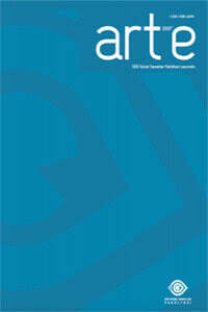"YETİŞKİNLER İÇİN HAYALET ÖYKÜLERİ" ABY WARBURG VE PATHOSFORMEL SANAT TARİHİ
"GHOST STORIES FOR ADULTS" ABY WARBURG AND PATHOSFORMEL ART HİSTORY
___
- Acar, B., (2010). “Sanat Tarihinde Kuramsal Yaklaşımlar II”, http://www.lebriz.com/pages/lsd.aspx?lang=TR§ionID=1&articleID=836&b hcp=1, Erişim tarihi: 2.12.2016.
- Agamben, G., (1994). “Aby Warburg and the Nameless Science”, Potentialities, Daniel Heller Roasen (çev.), Stanford University Press, Standford, p.89-166.
- Agamben, G., (2013). Nymphs, Amanda Minervini (çev.), Seagulls Books:, Utah.
- Akay, A., (2006). Sanat Tarihi Sıradışı Bir Disiplin, Yapı Kredi Yayınları, İstanbul.
- Belton, R. J., (2009). “Words of Art”, The University of British Columbia. https://people. ok. ubc.ca/creative/glossary/p_list.html, Erişim tarihi: 12.12.2016.
- Bing, G., (1960). “Storici e Storia: Aby M. Warburg”, Rivista Storica Italiana, 72(100-113) http://www.engramma.it/engramma_v4/warburg/fittizia1/27/bing.html, Erişim tarihi: 20.12.2016.
- Buchloh, B., (1999). “Gerhard Richter's "Atlas": The Anomic Archive” , October, Vol: 88 (Spring), The MIT Press, p.117-145.
- Campbell, J., (1991). The Power of Myth (with Bill Moyers), Anchor Books Edition, p.111.
- Cassirer, E., (1925). “Dedication letter to Aby Warburg, in Idem”, The Individual and the Cosmos in Renaissance Philosophy, M. Domandi (çev.), Oxford, Blackwell, 1963.
- DeMallie, R, J., (1985). The Sixth Grandfather: Black Elk's Teachings Given to John G. Neihardt, University of Nebraska Press, p.47.
- Durantaye, L. L., (2008). “Ghost Stories for the Very Adult”, The Believer, January, Vol 6, No: 1, p.26-30.
- Freedberg, D., (2004). “Pathos a Oraibi: What Warburg did not see”, http://www.columbia.edu/cu/arthistory/faculty/Freedberg/Pathos-atOraibi.pdf, Erişim tarihi: 20.12.2016.
- Freedberg, D., (2005). “Warburg’s Mask: A Study in Idolatory”, in Westermann, M. (ed.) Anthropologies of Art, Williamstown: Clark Institute, p:3- 25.
- Fernie, E., (1995). Art History and Its Methods: A Critical Anthology, Phaidon, London.http://www.columbia.edu/cu/arthistory/faculty/Freedberg/WarburgsMask.pdf, Erişim tarihi: 20.12.2016.
- Ginzburg, C., (2007). Efsaneler Amblemler İzler, Morfoloji ve Tarih, Mehmet Moralı (çev.), Kırmızı Yayınları, İstanbul.
- Gombrich, E. H., (1999). “Aby Warburg: His Aims and Methods: An Anniversary Lecture” Journal of the Warburg and Courtauld Institutes, Vol: 62, p.268-282.
- Hodapp, Christopher L., (2010). “Deciphering the Lost Symbol: Freemasons”, Myths and the Mysteries of Washington, D.C. Ulysses Press, Berkeley.
- Iversen, M., Melville, S., (2010). Writing Art History, Disciplinary Departures, Universtiy of Chicago Press, Chicago.
- Johnson, C., (2012). Memory, Metaphor, and Aby Warburg’s Atlas of Images, Cornell University Press, New York.
- Johnson, C., (2013). “A Biographical Fragment”, Mnmosyne Meanderings Through Aby Warburg’s Atlas”, https://warburg.library.cornell.edu/about/aby-warburg, Erişim tarihi: 19.12.2016.
- Kaek, M., (2016). “Of Marble Women and Sleeping Nymphs”, Translating Myth, Ben Pestell (ed.), Pietra Palozzolo, Leon Burnet, Routledge, New York, p.131-144.
- Manguel, A., (2008). Geceleyin Kütüphane, Dilek Şendil (çev.), Yapı Kredi Yayınları, İstanbul.
- Markman, P., Markman, R., (1989). Mask of the Spirit: Image and the Metaphor in Mesoamerica, University of California Press, Berkeley.
- Mooney, J., (1896). The Ghost Dance Religion and Wounded Knee, Dover Publications, New York.
- Papapetrosi, S., (2010). “World Ornament”, Anthropology and Aesthetics, Res 57/58 Spring Autumn, p.309-330.
- Preziosi, D., (1998). The Art of Art History: A Critical Anthology, Oxford University Press, Oxford, New York.
- Rampley, M., (2001). “Mimesis and Alegory: On Aby Warburg and Walter Benjamin”, Art History as Cultural History, Richard Woodfield (ed.), Overseas Publ, Amsterdam, p.121-151.
- Russel, Mark, A., (2007). Between Tradition and Modernity, Berghahn Books, New York.
- Steinberg, P. M., (1995). “Aby Warburg’s Kreuzlingen Lecture: A Reading”, Images From The Region of the Pueblo Indians of North America, Aby M Warburg, Cornell University Press, Ithaka p.59-110.
- Stimilli, D., (2013). “Aby Warburg’s Impresa”, http://imagesrevues.revues.org/2883, Erişim tarihi: 19.12.2016.
- Warburg, A., (1999a). “Dürer and Italian Antiquity, 1905”, The Renewal of Pagan Antiquity: Contributions to the Cultural History of the European Renaissance, David Britt (çev.), Getty Center for the History of Art and the Humanities, Los Angeles, p.553-558.
- Warburg, A., (1999b). “Pagan-Antique Prophecy in Words and Images in the Age of Luther, 1920”, The Renewal of Pagan Antiquity: Contributions to the Cultural History of the European Renaissance, David Britt (çev.), Getty Center for the History of Art and the Humanities, Los Angeles, p.597- 667.
- Warburg, A., (1995). “Images from the Region of the Pueblo Indians of North America”, Cornell University Press, http://www.jstor.org/stable/10.7591/j.ctt1g69xgc.5, Erişim Tarihi: 29.11.2016.
- Warburg, A., (1998). “Sandro Botticelli's Birth of Venus and Spring: An Examination of Concepts of Antiquity in the Italian Early Renaissance,1893”, http://tems.umn.edu/pdf/Warburg-Botticellis-Birth-ofVenus.pdf, Erişim tarihi: 29.11.2016.
- Warburg, A., (2001). “The Entry of the Idealizing Classical Style in the Painting Of Early Renaissance”, Art History as Cultural History, (ed.) Richard Woodfield, Overseas Publ., Amsterdam, p.7-33.
- Wind, E., (2009). “Warburg’s Concept of Kulturwissenschaft and its Meaning for Aesthetics”, The Art of Art History, (ed.) D. Preziosi, New York, Oxford University Press, p.189-194.
- Wolf, G., (2016). “Warburg’s Boticelli and Boticelli’s Nymph”, Boticelli ReImagined, (ed.) Mark Evans, Stefan Weppelmann, Victoria Alberts Publishing, Londra, p.102-106.
- Zilberg, J., (2011). A Note On Warburg, Transtechnology Research, Plymouth University, Plymouth.
- Resim 1. Sandro Botticelli, “La Primavera”, 1482. https://upload.wikimedia.org/wikipedia/commons/thumb/3/3c/Botticelliprimavera.jpg/1280px-Botticelli-primavera.jpg, Erişim tarihi: 18.12.2016.
- Resim 2. Hartwell & Hamaker, “Hopi Yılan Dansı”, 1899. https://www.loc.gov/item/90710791/. Erişim Tarihi:18.12.2016.
- Resim 3. Hopi çocuğunun çizdiği resim, Warburg arşivi. http://www.jstor.org/stable/10.7591/j.ctt1g69xgc, Erişim tarihi: 29.11.2016.
- Resim 4. Dürer, “Orfeus’un Ölümü”, 1494. https://en.wikipedia.org/wiki/Orpheus#/media/File:D%C3%BCrer_- _Mort_d%27Orph%C3%A9e_ (1494).jpg. Erişim tarihi: 29.11.2016.
- Resim 5. Dürer, “Melankoli”, Gravür, 1514. http://www.metmuseum.org/toah/images/hb/hb_43.106.1.jpg, Erişim tarihi: 29.11.2016.
- Resim 6. Francesco Cossa, “Mart Alegorisi: Minerva’nın Zaferi”, 1476-1484. https://upload.wikimedia.org/wikipedia/commons/d/d9/Francesco_del_Cossa_ -_Allegory_of_March_-_Triumph_of_Minerva_-_WGA05394.jpg, Erişim tarihi: 29.11.2016.
- Resim 7. Aby Warburg, Mnemosyne Atlas, 1926-1929. http://www.kunstkritikk.no/wpcontent/uploads/2015/05/aby_warburg_tavole_mnemosyne.jpg, Erişim tarihi: 29.11.2016.
- Yayın Aralığı: Yılda 2 Sayı
- Başlangıç: 2008
- Yayıncı: Süleyman Demirel Üniversitesi Güzel Sanatlar Fakültesi
Somut Olmayan Kültürel Miraslardan El Örgüsü Çoraplar: Gölova Yöresi Örneği
Paula Rego ve Resimlerindeki Öz Yaşam Öyküsel Çıkarımlar
F. Deniz KORKMAZ, Düriye KOZLU
Türkiye’deki Popüler Müzik İkonlarının Gazetelerin Magazin Sayfalarında Yer Alma Durumu
MARKA KENT OLUŞTURULMASINDA GRAFİK TASARIMIN ROLÜ VE GAZİANTEP ÖRNEĞİ
Ahmed Abdusselam TOKOĞLU, Murat ÇELİKER
Geleneksel Çömlekçilikte Değişim ve Yüksek Pişirim Cazibesi
Atasözlerinin Kaynağı, Özellikleri ve Geleneksel Türk Tiyatrosunda Kullanımı Üzerine Bir İnceleme
DUYULARIN MEKÂNSAL DENEYİMLERİ ŞEKİLLENDİRMESİ: SAGRADA FAMİLİA KİLİSESİ
Neşe Çakıcı ALP, Yasemin Erkan YAZICI
TEKİNSİZİN ESTETİĞİ ve SANAT YAPITI
"YETİŞKİNLER İÇİN HAYALET ÖYKÜLERİ" ABY WARBURG VE PATHOSFORMEL SANAT TARİHİ
